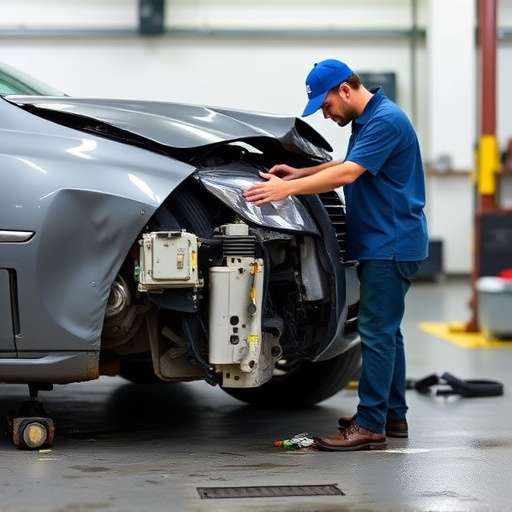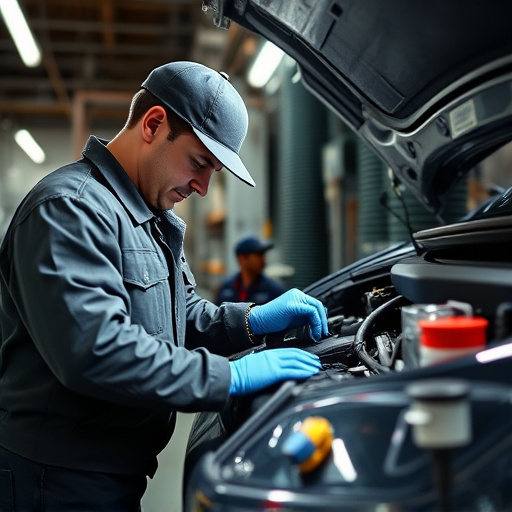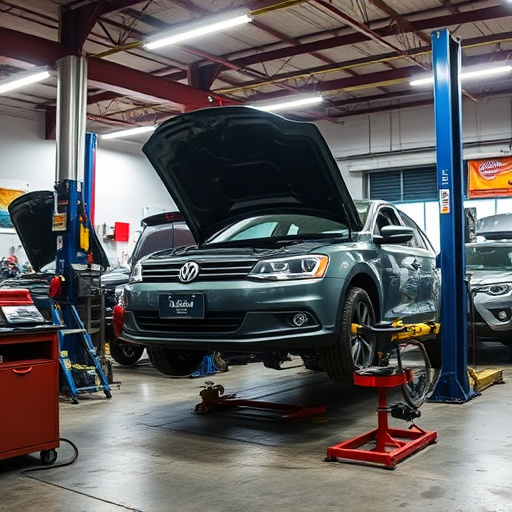Mercedes high-voltage disconnect (HVD) is a specialized safety procedure for modern Mercedes vehicles, requiring precise tools and knowledge to isolate high-voltage components like batteries and electric motors during service or repair. This process, vital for post-incident recovery, involves specific lockout steps such as parking brake engagement, door locking, and handbrake application. Strict safety protocols, including detailed HVD procedures, are crucial in modern automobiles to prevent shocks, fires, and damage during tasks like bumper repair or body work.
“Uncover the essential process of a Mercedes high-voltage disconnect, a critical safety measure in today’s electric vehicle landscape. This comprehensive guide navigates vehicle-specific lockout steps, ensuring a secure and efficient procedure. From understanding the intricate high-voltage systems to implementing effective safety protocols, this article empowers professionals with the knowledge required to handle such sophisticated technology. Discover the step-by-step approach to prevent unauthorized access and maintain the integrity of Mercedes’ advanced electrical architecture.”
- Understanding Mercedes High-Voltage Disconnect
- Vehicle-Specific Lockout Procedures: A Step-by-Step Guide
- Effective Safety Measures for High-Voltage Systems
Understanding Mercedes High-Voltage Disconnect

Mercedes High-Voltage Disconnect is a specialized procedure designed to safeguard the intricate electrical systems found in modern Mercedes vehicles. This process involves the strategic removal and isolation of high-voltage components, ensuring that power is cut off from critical systems like the battery and electric motors. By implementing these vehicle-specific lockout steps, auto body services specializing in Mercedes can effectively protect both the vehicle’s integrity and the safety of technicians during service or repair.
Understanding the Mercedes High-Voltage Disconnect process is crucial for any car bodywork expert. It requires meticulous attention to detail, precise tools, and a deep knowledge of the vehicle’s architecture. This method not only enhances the efficiency of repairs but also mitigates potential risks associated with working on high-voltage systems, ensuring that every auto body service performed aligns with the manufacturer’s standards.
Vehicle-Specific Lockout Procedures: A Step-by-Step Guide

Mercedes high-voltage disconnect procedures are crucial for safe and effective vehicle recovery after an incident. The process involves a step-by-step lockout approach tailored to each Mercedes model, ensuring minimal damage and optimal safety. It begins with the activation of the vehicle’s parking brake and shifting it into park. Next, all doors must be locked manually, followed by the deployment of the handbrake for enhanced security. In cases where a collision has occurred, engaging the high-voltage disconnect system becomes vital. This involves isolating the vehicle’s electrical system by removing specific connectors, preventing any potential short circuits or hazards associated with residual energy.
For an auto collision center or collision repair shop dealing with Mercedes vehicles, understanding these lockout steps is essential. It enables them to efficiently handle post-accident scenarios, ensuring a systematic and safe process. By following these guidelines, professionals can effectively manage high-voltage systems, prepare the vehicle for further assessment, and minimize the impact of electrical discrepancies that may arise after a collision.
Effective Safety Measures for High-Voltage Systems

In the realm of modern automotive technology, high-voltage systems have become an integral part of many vehicles, especially in Mercedes models known for their advanced engineering. Implementing effective safety measures is crucial when dealing with such systems, particularly during processes like a Mercedes high-voltage disconnect. This involves following specific lockout steps to prevent any accidental activation that could lead to severe electric shocks or fires.
For enthusiasts engaged in classic car restoration or automotive body work, understanding these security protocols is vital. Unlike simpler electrical systems, high-voltage components require meticulous handling due to their potential for catastrophic failures. By adhering to the prescribed procedures, mechanics and restorers can ensure a safe working environment, safeguard themselves and others from harm, and prevent damage to both the vehicle and nearby equipment during processes like bumper repair or intricate automotive body work.
The implementation of a Mercedes high-voltage disconnect, following precise vehicle-specific lockout procedures, is essential for both safety and security. By understanding the intricate nature of these systems and adhering to the step-by-step guide provided, you can effectively prevent unauthorized access while ensuring the integrity of modern electric vehicle (EV) architectures. Incorporating robust safety measures for high-voltage systems not only protects against electrical hazards but also safeguards valuable components from potential damage or theft.














